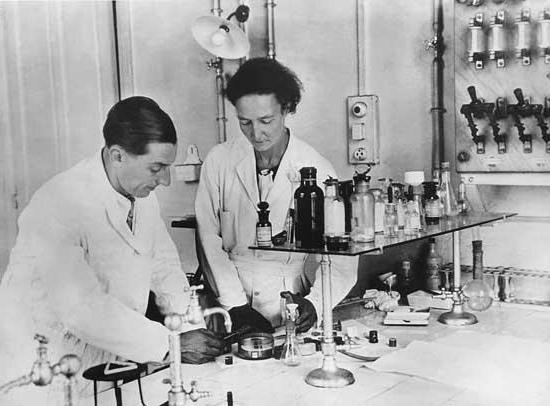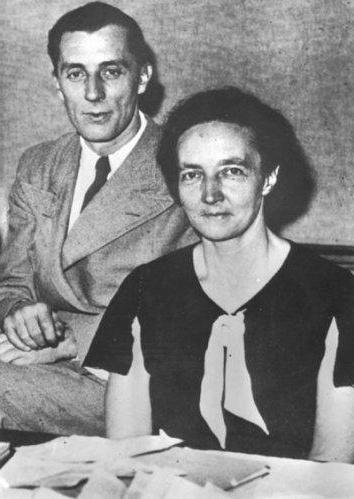
Frederic Joliot-Curie - Famous Publicfigure and French physicist. He was among the leaders and founders of the Pugwash movement of scientists, as well as the Peace Advocates Movement. Together with his wife Irene received the Nobel Prize in Chemistry. This article will present his brief biography.
Jean Frederick Joliot was born in Paris in1900 The boy's father, Henri, was quite successful in commerce, and his mother, Emilia, came from a Protestant family. Frederick was the youngest in the family of Joliot, numbering six children.
In 1910, the boy was sent to study atboarding school Lacanal. Seven years later, Jean returned to Paris and decided to devote his own life to science. In 1920, a young man entered the High School of Applied Chemistry and Physics. In 1923, Joliot graduated with the best result in the group.

Frederick received an engineering degree.During his studies, he acquired good skills in the practical application of physics and chemistry. But most of all, Jean was interested in basic scientific research. This was due to the influence of Paul Langevin (French physicist). It was with him that Frederic discussed his plans for the future when he returned home after military service. Paul advised Joliot to get an assistant at the Radium Institute for Marie Curie. In 1925, Frederick began to work as a preparator in this educational institution. In his free time, the young man continued to study physics and chemistry.
At the institute, Joliot met Mary’s daughternamed Irene. A year later, the young people got married. After that, Frederick took a double surname - Joliot-Curie. Wife followed suit. Soon the couple had two children - a daughter and a son (both became scientists in the future).

After the wedding, the hero of this article continuedwork at the Radium Institute. In 1930, he received a doctoral title for the study of the radioactive component of polonium. But, even despite the degree, almost no one in the scientific community knew the name of Joliot-Curie. That is, he was little known.
Frederick tried to find an academic positionbut his attempts were unsuccessful. The scientist was already thinking about getting a practical chemist for industrial production. Joliot-Curie was helped by Jean Perrin. Thanks to a colleague, Frederick won a government scholarship and was able to stay at the institute. In 1930, the German physicist Walter Bothe discovered that when bombarded with helium nuclei (formed during the decay of polonium) of boron and beryllium, the latter emit high penetrating radiation.
The presence of engineering education allowedJoliot-Curie to create a sensitive detector with a built-in condensation chamber. This device recorded penetrating radiation. Polonium was taken as the first sample. In 1931, Frederick and his wife began research. In the course of the experiment, they found out that if a thin plate of a hydrogen-containing substance was placed between the irradiated boron (or berrylium) and the detector, the initial radiation level would be doubled.

Additional experiments explained the natureadditional radiation. It turned out that it consists of hydrogen atoms, which, when colliding with radiation, acquire a rather high speed, although neither Frederick nor Irene fully understood the essence of the process. However, thanks to the results of their research, James Chadwick in 1932 discovered the particle neutron, which is part of the atomic nucleus. At the same time, the American physicist Carl D. Anderson wrote about positrons, which became by-products during an attack with alpha particles of aluminum or boron.
Irene and Frederick engaged in their research andset a new experiment. They placed samples of aluminum and boron in the condensation chamber, and its opening was closed with thin aluminum foil. Then the couple began irradiation with alpha radiation. Positrons really began to stand out, but after the elimination of the polonium source, their emission lasted only a few minutes.
So, Frederick and Irene found thatSome irradiated samples of boron and aluminum were transformed into new chemical elements. In addition, they became radioactive. Boron turned into a nitrogen isotope, and aluminum into phosphorus.

In 1935, Irene and Frederick were awardedNobel Prize for the synthesis of new radioactive elements. Thus, the name Joliot-Curie was forever inscribed in the history of chemistry. In his Nobel speech, the scientist noted that artificial radioactive elements should be used as labeled atoms. This will greatly simplify the problem of finding and eliminating various components that are in a living organism.
In 1937, the physicist Joliot-Curie continued to workat the Radium Institute. He also received the post of professor at the Paris College de France. Here the scientist opened a research center for nuclear chemistry and physics. Frederick also created a laboratory where specialists from different profiles could work closely together to achieve the best result. In addition, the physicist controlled the construction of the first cyclotron in France, where it was planned to make radioactive elements as the source of alpha particles.

In 1939, the German chemist Otto Gan committedopening. He told the scientific community about the possibility of dividing the uranium atom. Following this, Joliot-Curie proved that it is explosive in nature. The physicist understood the enormous amount of energy released in the process of atom fission. To use it, Frederick bought almost all of the available supply of heavy water from Norway. But the scientist’s research was interrupted by the world war that broke out at that time. France was occupied by the German army. At great risk, Joliot-Curie transported all the heavy water to England, where scientists used it during the development of atomic weapons.

During the occupation, Frederick remained in Paris.Despite the fact that the scientist was in the French Socialist Party and had anti-fascist views, he retained his posts at the College de France and the Institute of Radium. Also Joliot-Curie was a member of the Resistance Movement and stood at the head of the “National Front” (an underground organization). And Frederick used his laboratory to manufacture radio equipment and explosives that were delivered to the Resistance fighters. In the midst of war, the scientist followed the example of his teacher Langevin and joined the Communist Party.
After the liberation of the French capital of the heroArticles have been appointed to the post of director of the National Center for Research. Frederick was supposed to revive the scientific potential of the country. At the end of 1945, the scientist requested President Charles de Gaulle. Joliot-Curie wanted to create an Atomic Energy Commissariat in France. Three years later, the physicist headed the launch of the country's first nuclear reactor. This significantly increased his credibility as a scientist and administrator. Nevertheless, Frederick’s membership in the Communist Party caused discontent among many. In 1950 he was dismissed from the post of director of the Commissariat.

The last years of his life Frederic Joliot-Curie,biography of which was presented above, devoted to teaching and research work. He also headed the World Council and was active in political activities. In 1956, Irene died. The death of his wife was a heavy blow for Frederick. But he had to pull himself together and head the Radium Institute. Joliot-Curie also supervised the construction of a new university in Orsei and taught at the Sorbonne. However, soon his body, weakened by previously transferred hepatitis and stress, failed. In August 1958, the scientist died in Paris.
Colleagues characterized Frederick aspatient, kind and sensitive person. He loved to read, paint landscapes and play the piano. In 1940, F. Joliot-Curie received the Barnard Gold Medal from the Columbia Institute for outstanding scientific services. And in the USSR, Frederick was awarded the Stalin Prize, awarded "For the strengthening of peace among nations."


























